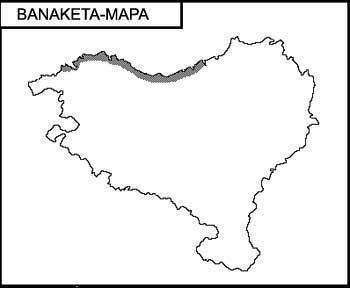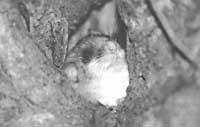Herons: long legs, sharp beak
1991/01/01 Aihartza, Joxerra Iturria: Elhuyar aldizkaria
Birds are undoubtedly those with less variability between vertebrates and basic anatomical structures. However, this basic model of birds offers a great plasticity, so they are able to adapt to very different life forms through minimal changes and colonize very different habitats and ecological places. A good example of this adaptation to specific lifestyles and residence is offered by the flocks, families formed by herons, egrets and similar birds.
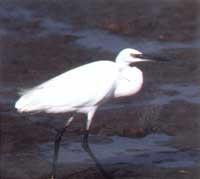
The Ardeidae family consists of sixty species scattered around the world, most of them tropical. In Euskal Herria, however, it can be said that six of the nine European species live, although for the moment only five safe nesting.
All pests are predators that live in humid environments and can be found in both freshwater and brackish sea branches.
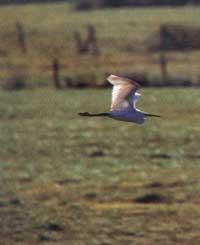
The most obvious feature of these birds is the length of the different parts of the body. They are so long and thin that they often pass from simplicity and elegance in their movements to the fiercest clumsiness. However, the long and thin legs are very useful not to chase away their prey. At the same time, the sharp beak in the form of azcons and the flexible long neck have appropriate hunting tools to catch their monstrous prey.
An exceptional spectacle is that of the little garceta (Egretta garcetta), which moves slowly in the water, standing on one leg, with the neck thrown back, while directing the sharp beak forward and down. Then the other leg is immersed in the water and slowly moves from the bottom forward, in order to move some fish that accompany it. If any prey is discovered, release the neck in the form of a crossbow, throwing the sharp beak forward and catching fish, frog or whatever.
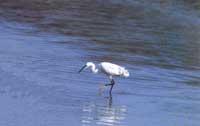
The little Egretta Garcetta (Egretta garcetta) is a slender, medium-sized earring, dressed in a fine, soft, pure white feather. The very sharp beak is black and its long legs, characterized by its striking presence. In times of heat, and like most of the plows, this elegant look is added long and fine feathers that come out of the nape as ornament. These soft and beautiful feathers were damaged by these animals. And the XIX. At the end of the 20th century thousands of herons, egrets and others were cleaned to obtain provisions of hats and women's clothing. This activity, due to the colonial life of these birds, seriously affected the populations of the ardeidos, since the hunters killed dozens of them under compulsion.
Although in Euskal Herria it is a scarce nest, which is only reproduced in two areas of Navarre, it can be said that the small heron has become common in migratory times and as winter in the humid areas of our territory. This abundance, however, is new, and is considered a consequence of the strong expansive tendency of the species throughout Europe. For example, although until 1981 it has been curious in the estuary of Urdaibai, in recent years the number of egrets circulating in it has grown dramatically, becoming a normal winterer (Galarza, 1989).
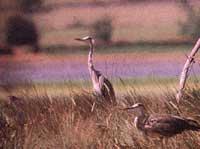
The little heron is a gregarious bird that lives by day and that, except in zeal, is silent custom. It does not establish strict conditions regarding its habitat, but can also inhabit lakes and swamps, as well as rice paddies and marshes, where it feeds on fish, amphibians and insects. However, for reproduction, and like the rest of the trees, in addition to a dense vegetation of trees, viaducts or carrizales, it needs tranquility to form its colonies, something that unfortunately we only offer today in some lagoons of Navarra.
Lertxun hauskara (Ardea cinerea) is the largest ardeid in Europe. With a length of 90 cm and a fin width of up to 170 cm, it is one of the few large birds with wide diffusion in the Euro-Siberian region, and can also be seen in Euskal Herria, in some places in large groups, although, as in the case of the small heron, it is above all a winter visitor of our wet means.
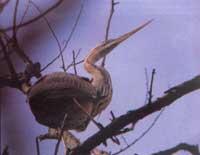
The royal heron is a kind of great adaptability, which only requires abundant fishing and a human tranquility to adapt to a medium, but as has been said, this last condition is especially difficult to find in the Basque Country, since in it you can find an environment little propitious and, probably, a human pressure too high.
As a great fisherman/hunter, the royal heron needs 500 grams of food a day, among which you can find fish, frogs, insects, snakes, rats, chicks from other birds and adult heath (Tachybtus ruficollis). Thanks to the dilating esophagus that the ardeids have, it usually devours the whole trapped; their hard canvases also break down the bones, while the hairs, fingers and scales expel them forming a hairy ball known as “egagrophilus”.
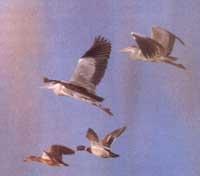
In breeding areas fragile herons gather together forming large colonies, usually choosing the highest branches of trees for nesting. Unfortunately, no reproduction has been observed in the Basque Country. However, in the spring of 1990 the presence of an adult couple in the lagoon of Pitillas during the heat, as well as the transport of nesting materials has been observed, so it is possible that if the humid means are lightly cared for it can be incorporated in the short term to the list of nesting birds of the Basque Country.
Although somewhat smaller than the previous one, the red heron (Ardea purpurpurpurea) presents a similar appearance and customs. However, the geographical distribution of this species reflects a more thermophilic custom. In fact, although they abound in South and East Asia, the Middle East and South Africa, their distribution in Europe is limited to the vicinity of the Mediterranean and to scarce areas of France and Holland. It is also common in the peninsula itself, in the south and in the center, but in the north it is very rare. In addition, European populations are migratory and after reproduction they escape the Sahara in search of tropical regions.
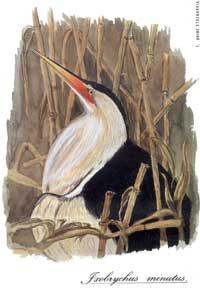
In Navarra there have been around twenty-five breeding pairs, always in the lagoons and banks of the bank and with the most important populations in the lakes of Biana and Pitillas.
Unlike the previous species, the red heron prefers reed to nest the tree, and although it tends to make it in colonies, it can also do it individually in low-density areas.
The colouring of its plumage is also adapted to the reed life: the dark longitudinal lines that appear along the neck and chest have a clear disruptive function that makes the animal lose shape between the reeds. That is why, like bird bulls (Botaurus stellaris) and small amiltxis (Ixobrychus minutus), also the red herons, above all that may pose a danger, adopt a “barrier posture”; or put another way, they become long and with the beak facing the sky, becoming an invisible inside the reed. Chitos take the same stance if someone approaches the nest.
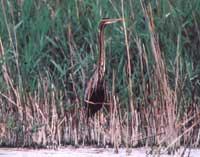
The nest of the red heron is an excellent platform of reeds and reeds folded and stuck together (usually about 2 m above the surface of the water) where the female lays 4-6 blue eggs. The chickens that are born are the nidicolas and take care of their food, composed of fish, frogs, snakes, etc., brought by adults to the chest.
Among the trees, adapted to live in the reed, is the common bird bull (Botaurus stellaris). This is a curious name for the heron, but its reason is evident if in some silent night of spring we can hear the thick song of the time of this peculiar animal. And remember the short and modest script of the res.
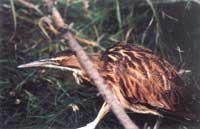
The bird bull is a fleeting bird that lives at dusk and/or at night, the size of a hen, with little fondness of the hillside, and that normally does not leave the protection of the reed in the shade. Thanks to its brown color drawn and painted of its feathers, there is an unprecedented among strollers, its main defense being camouflage. It has no nutritional differences with the rest of the herons, and also lives hunting small fish, insects and invertebrates.
Its fleeting character makes the bird bull a solist bird that does not produce colony. The shortage of European populations may be related to the type of habitat of this animal. And it is that the bird bull needs large reeds to carry out his life, and unfortunately we have greatly reduced the reeds throughout the last century.
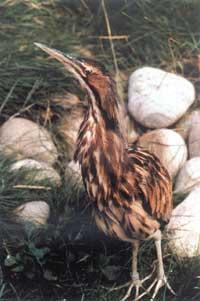
In Euskal Herria only bird novillists have been found in Navarra, being sedentary in this country. However, the population of bird bulls is very small, and so far it has only been seen in the lagoons of Biana and Pitillas, with two or three pairs in total, although the hidden life of these birds can take them elsewhere.
Common Amiltxori (Nycticorax nycticorax), the same size as the bird bull, is a small plow that makes a dusk and night life. In fact, the Latin name of this garceta — “the raven of the night” — comes from these nocturnal customs and the rough carracas that he throws at dusk towards the hunting places.
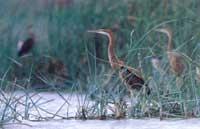
Amiltxoria is a widely diffused bird. He lives in South America, Africa and the temperate regions of Eurasia. Arboreal and colonial bird, does not present a cryptic coloration of the bird bull than in young specimens, and the plumage of adults is usually more similar to that of the royal heron, characterized by red eyes. Morphologically it moves slightly away from the typical herons. Her neck is short, and the beak and legs are not so long either. These modifications can be considered as a closed vegetation and an adaptation for better circulation of tree branches.
Amiltxoria is protected during the day between the willows and tamarils of the reed areas and banks. When twilight arrives, it approaches the banks of the river or small swampy uraxals to hunt aquatic insects, crustaceans and vertebrates.
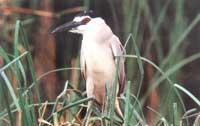
European populations are formed by migratory groups that invest in tropical Africa. By April, the amylarros come to reproduce to the north.
Despite its scarce presence in the Basque Country, in recent years the various humid environments of the Navarre riverbank are being colonized, from Biana to Tudela, where permanent populations have been established in various parts of the Ebro river environment.
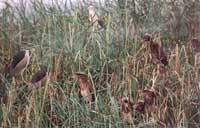
Finally, the small bird (Ixobrychus minutus) is the sixth species to stand out among the Basque Country's fences. This is a very small heron, 35 cm long, 55 cm wide and weighing only 150 g. As for the color of the plumage, this is the middle between the common amiltxori and the bird bull. He is able to live close to human beings without anyone realizing his ability to hide. Faced with what you can risk, this bird also adopts a “barrier posture”, and if the wind hits the reed, it imitates the movement of reeds with the neck.
The little Amiltxori is also an animal of nocturnal customs, which starts from hunting, especially, the sunset. When working in this work, in the reed circulates above the water and with absolute silence, keeping the reeds with long fingers and jumping some piece in the water. In the same way, just hold both reeds to ascend the reed and catch the tempting joke located at the end of some plant.
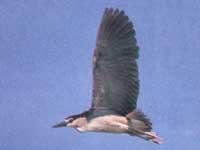
The small Amiltxori inhabits the marshes, reservoirs, lagoons and banks of the temperate regions of Eurasia, with a small compact reed of adaptation. European populations are migratory and, once reproduction is completed, young people begin to experience dispersive movements towards August towards tropical Africa.
In the Basque Country the small bird is very scarce and in this species have also been observed in Navarre, although it has also been detected in some areas of southern Alava. Reproduction has not been detected anywhere in our territory, but it has been estimated that in Navarre there are a dozen nesting couples and that due to the fleeting habits of the animal can become more.
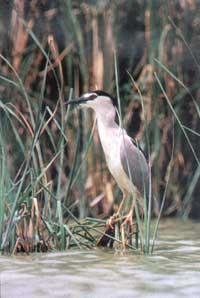
Finally, although at present a process of expansion can be observed in some trees, in general the development of this group of birds is still very uncertain. It is evident the need to protect the humid environments that host these animals to ensure their conservation and that of other species. Unfortunately, protection measures against these means are not sufficient. In fact, due to its predatory nature, the pests, located at the top of the trophic pyramid, can be especially sensitive to insecticides, pesticides, etc., which are transported dissolved in the water, due to increased concentration of this type of toxins along the trophic chains. Therefore, in addition to preserving the physical space of the humid media, it is necessary to know and control all activities that may occur around them, if we want to maintain these important ecosystems and their inhabitants.

Gai honi buruzko eduki gehiago
Elhuyarrek garatutako teknologia




